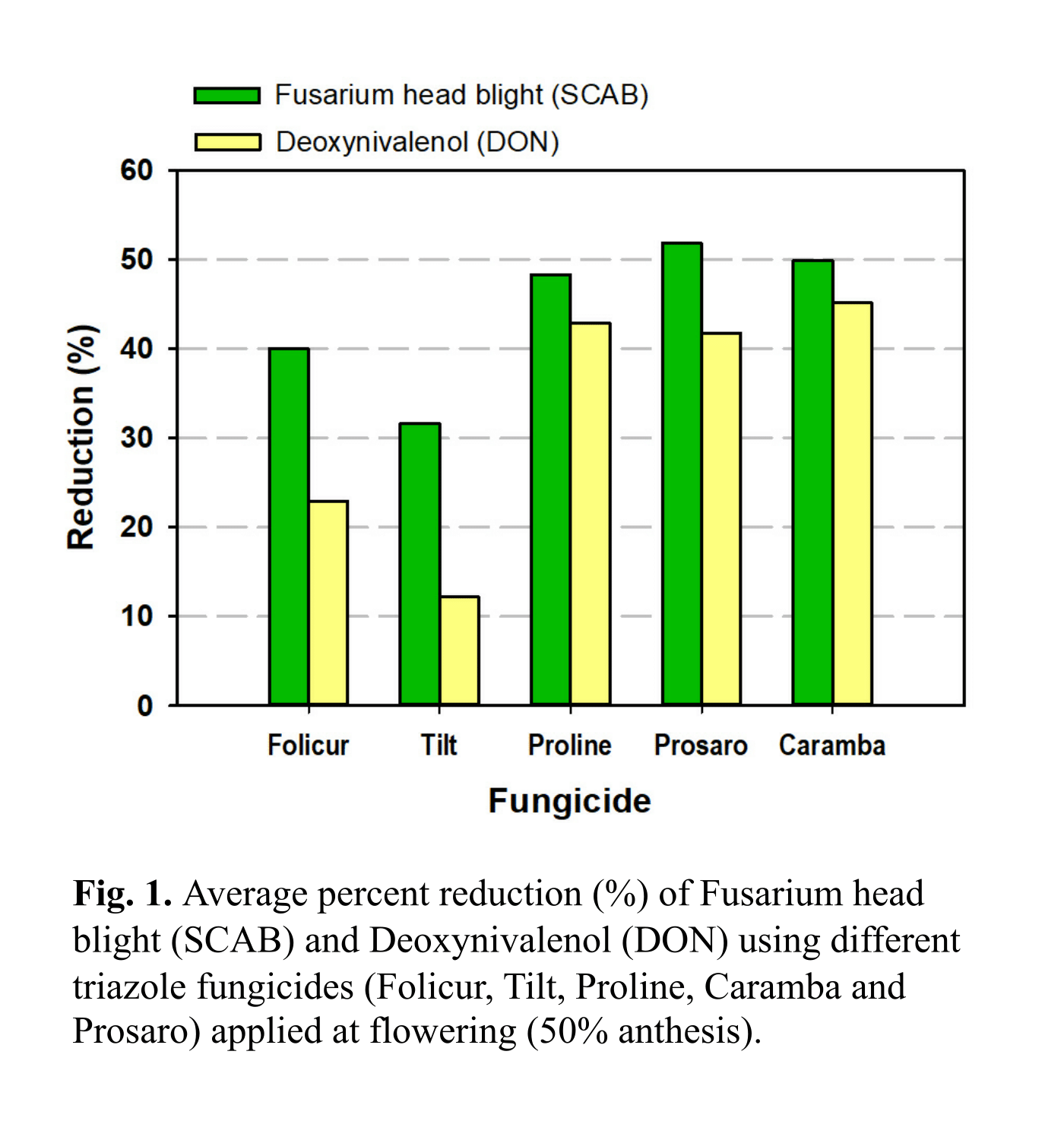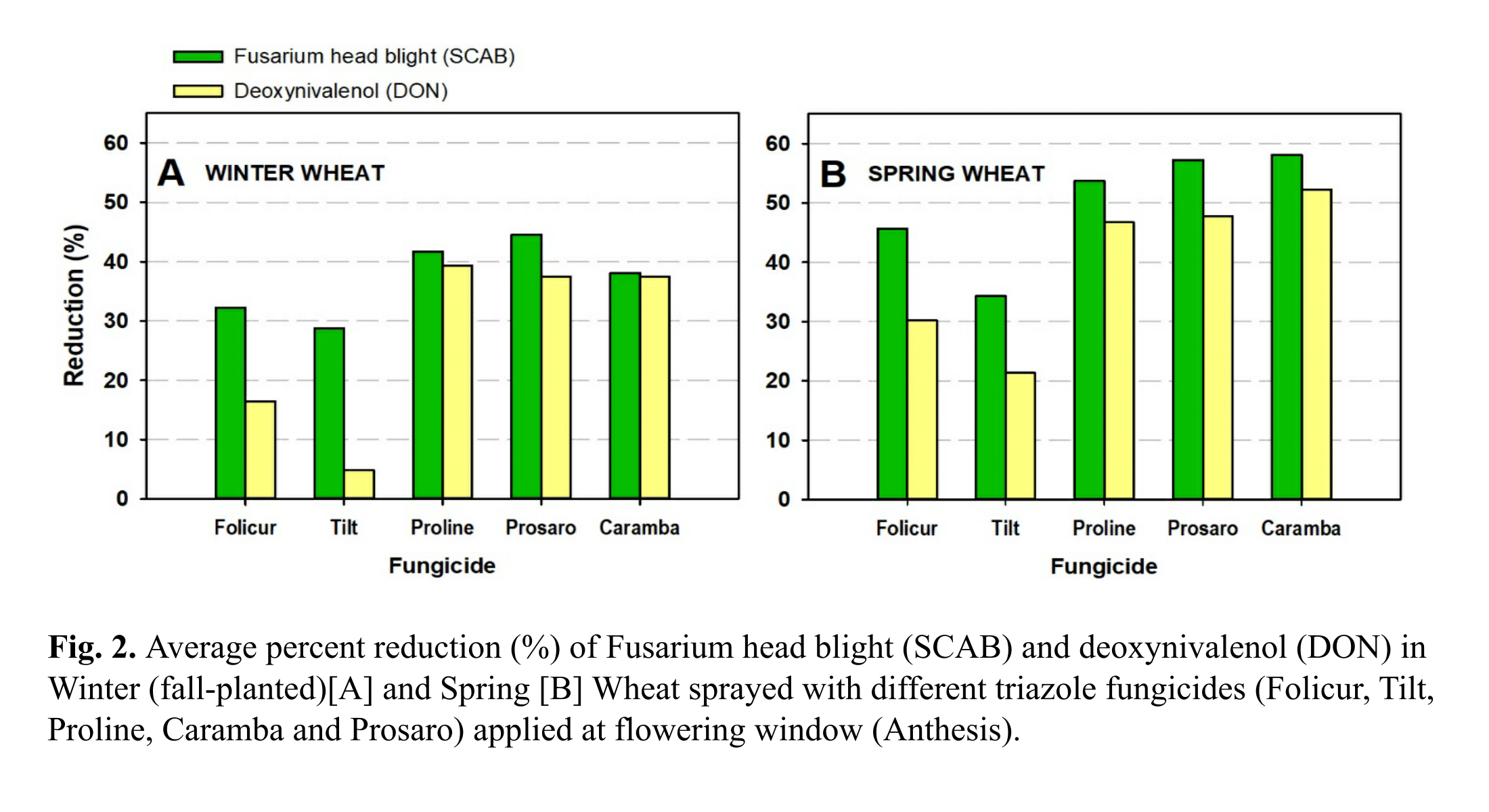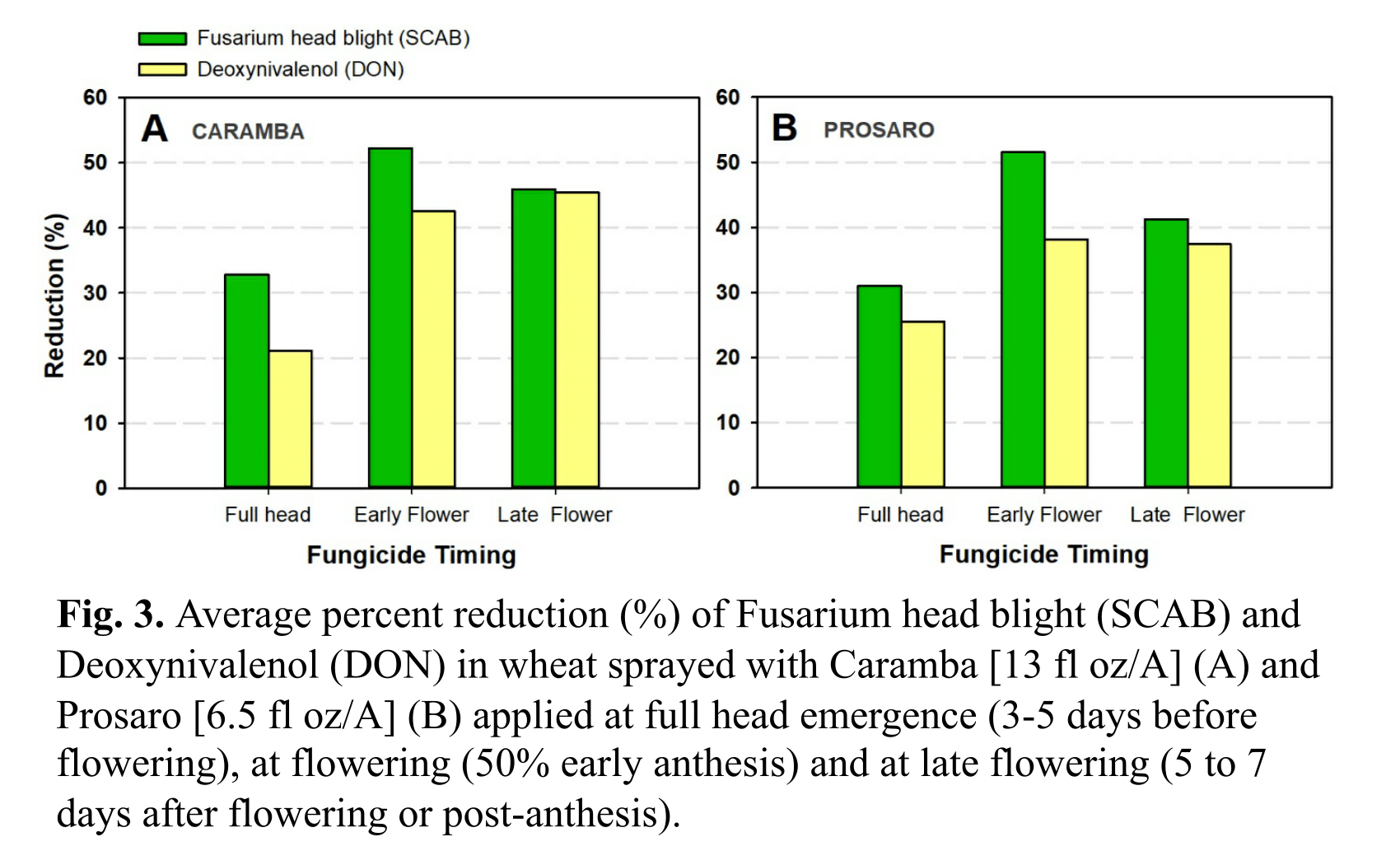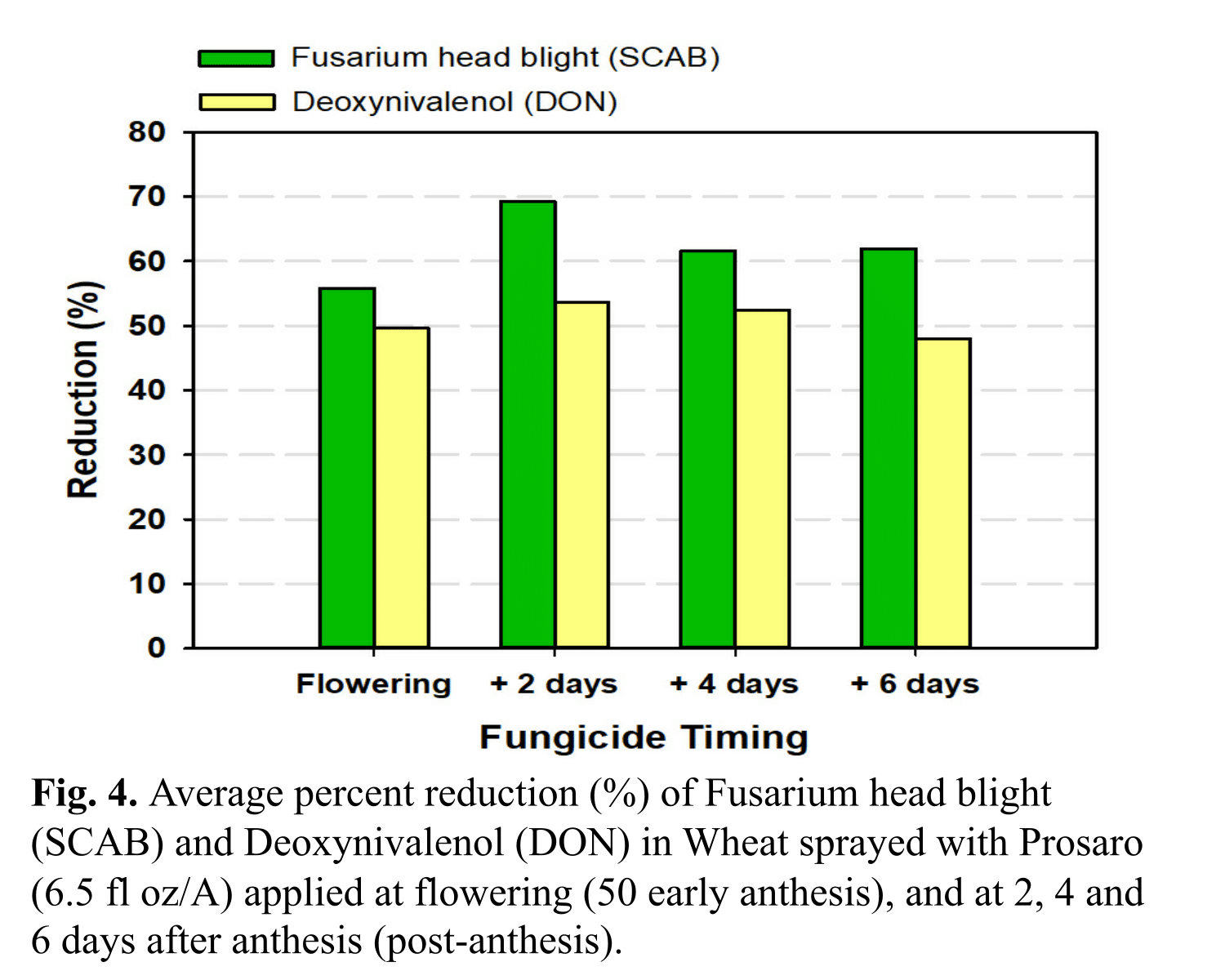ScabSmart: Use of Fungicides
Use of Fungicides
Images on this page can be clicked to view a larger version, then use your back button to return to this page.
One effective strategy to manage Fusarium head blight (scab) and deoxynivalenol (DON) in wheat is by means of using fungicides. Based on studies done across the U.S. in both spring and winter wheat-producing regions, the application of triazole fungicides (i.e. Folicur®, Tilt®, Proline®, Caramba® and Prosaro®) can reduce scab from 32 to 52%, and DON from 12 to 43% (Figure 1).
Comparisons among these fungicides showed that Proline®, Caramba® and Prosaro® gave the best results in reducing both scab and DON. Interestingly, a higher percent control of both scab and DON was observed in spring wheat compared to winter wheat (fall-planted) cultivars. These results showed that an overall 40 to 50% reduction of scab/DON can be achieved in both wheat grain classes when fungicides are sprayed at flowering or during the anthesis window (Figure 2).
Besides triazoles, other fungicide chemistries (e.g. strobilurins) have been evaluated to control scab and DON. A recent study conducted in 17 U.S. states compared strobilurin formulations (Headline®, Twinline®, Evito®, Quadris®, Stratego-YLD® and Quilt Xcel®) applied in single applications or in combination with a triazole to control scab and DON in soft red winter wheat cultivars. Results show that the effects of strobilurins were inferior to those from triazole-based fungicides (Folicur®, Proline®, Caramba® and Prosaro®), even when strobilurins were applied in combination with triazoles (Table 1).
Fungicide programs that used triazoles fungicides alone (Proline®, Caramba® and Prosaro®) and were applied at flowering (50% anthesis), had a higher reduction in both scab and DON compared to programs which included strobilurins fungicides.
Whether strobilurins were applied alone, as premixes or in combination with triazoles, their results were always inferior to a triazole alone based program and in most cases reduced scab and DON below 30%. In fact, all treatments that included a strobilurin fungicide, with the exception of Stratego YLD®, resulted in an increase in DON content, regardless if they were applied at full flag emergence, boot or full head emergence (Table 1).
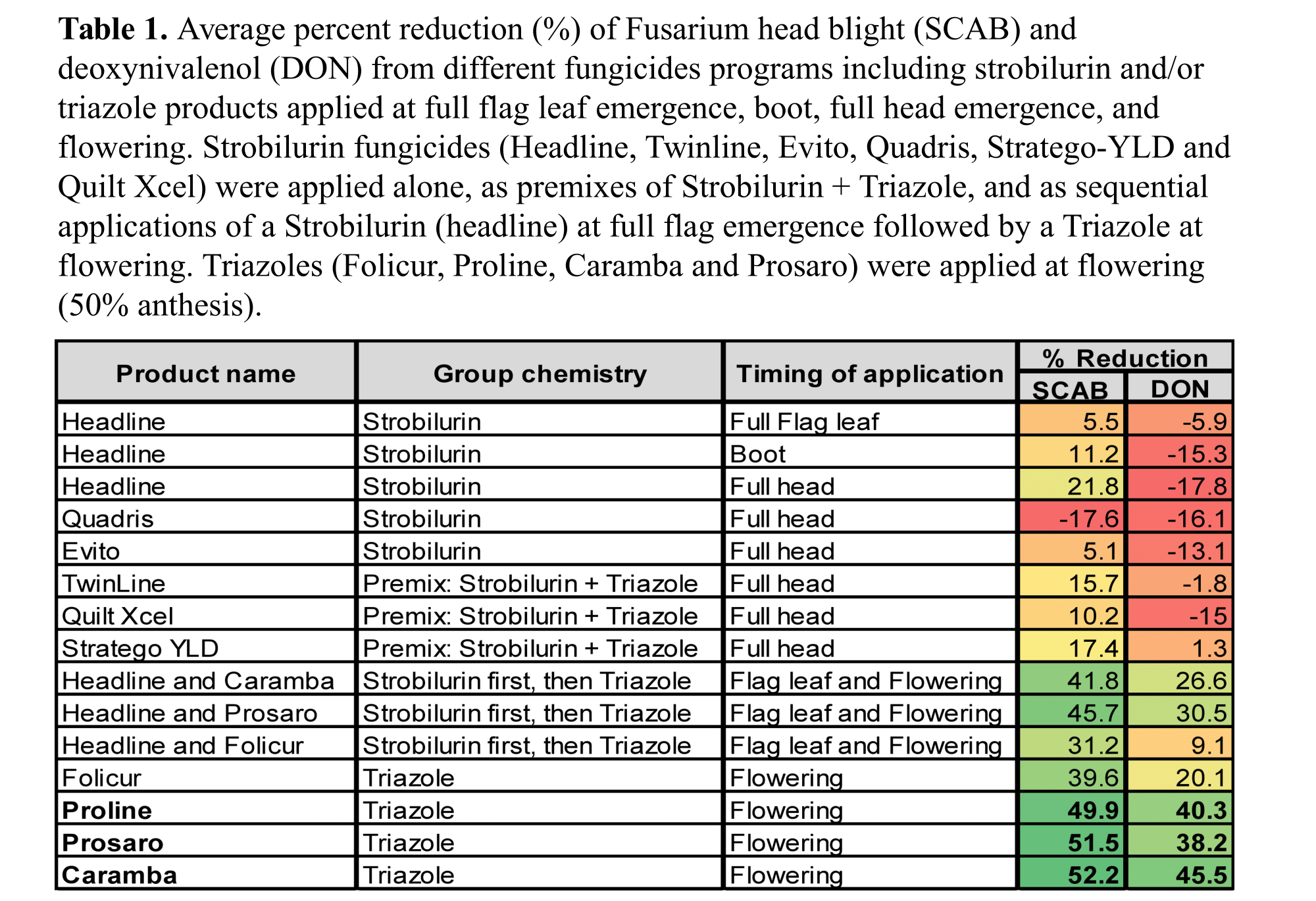
In summary, Proline®, Prosaro® and Caramba® are the most effective triazoles to control scab and DON. These fungicides should be applied at the recommended flowering window to reduce the risk of grain yield and quality losses associated with Fusarium head blight.
However, the efficacy of spraying fungicides to reduce scab and DON could be influenced by weather, field conditions and crop development. For example, rain can prevent appropriate timing of application at anthesis and delay sprays. Wet fields can also cause a reschedule of fungicide applications; and the flowering window can extend for several days due to differences in tiller development within a wheat cultivar or maturity differences between fields.
Therefore, data was collected from fungicide trials conducted in several locations in the U.S. during the past 10 years to evaluate the effects of pre-anthesis (full heading) and post-anthesis (late flowering) fungicide application timing on scab and DON. Figure 3 shows results from applying Caramba® and Prosaro® at full head emergence (3-5 days before flowering), at early flowering (50% early anthesis) and at late flowering (5 to 7 days after flowering or post-anthesis).
Compared to a non-treated reference, both fungicides reduced scab by about 52% when they were applied at early flowering (50% anthesis) and from 41 to 46% when they were applied at late flower or post-anthesis (5-7 days). Similarly, both products reduced DON from 38 to 43% when applied at early flowering and from 37 to 45% when application was done 5 to 7 days post-anthesis. Applications at full head emergence were not as effective as those during the flowering window (early or late applications) with an average reduction of 31 to 33% for scab and 21 to 25% for DON (Figure 3).
Similar studies conducted in Ohio and Illinois showed that post-anthesis applications (2, 4 or 6 days after anthesis) of both Caramba® and Prosaro® can be as effective or more effective than applications done at early flowering (50% anthesis).
Compared to early flowering applications, when Prosaro® or Caramba® were sprayed 2 to 6 days later, the reduction of scab ranged from 62 to 69% and similarly, DON reduction ranged from 48 to 54%. These represent an increase in reduction in scab from 13 to 30% and DON from 6 to 8%. These results suggest that scab and DON can still be managed and reduced by means of spraying fungicides even when conditions in the field and crop development prevent early flowering applications (Figure 4).
Final RemarksAll results are useful to develop effective management strategies that include fungicide applications to control Fusarium head blight and DON. In addition to this information, consider the use of best application technologies, follow forecasting systems and apps, implement cultural practices to reduce crop residue and consult with your extension program and crop advisors in decision making to increase the odds of minimizing scab and DON in Wheat fields and grain.
On the next page (Integrated Management) we will review the importance of integrating cultivar resistance with fungicide treatments, expand on more results from fungicide application timing and discuss grain harvesting strategies to minimize the effect of Fusarium head blight on wheat grain and quality.

